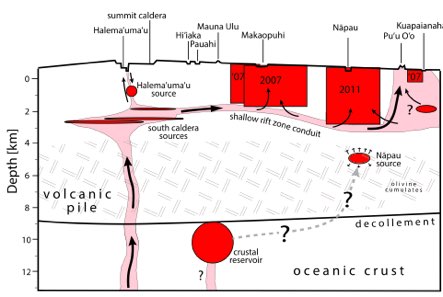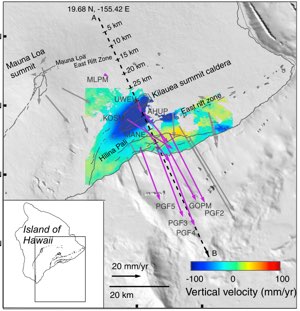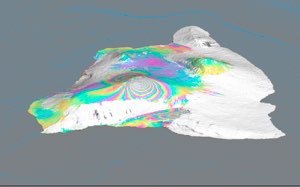Magma body in Kilauea’s East Rift Zone
 It is well known that Kilauea volcano has multiple magma reservoirs in the summit area but much less is known whether there are reservoirs elsewhere within the volcano. InSAR data after the 2011 east rift zone intrusion reveal that the area around Napau crater inflated for several months, which is evidence for a reservoir in this area. A pressurized magma reservoir within the rift zone has implications for the state of stress within the volcano, as we discuss in our GRL paper.
It is well known that Kilauea volcano has multiple magma reservoirs in the summit area but much less is known whether there are reservoirs elsewhere within the volcano. InSAR data after the 2011 east rift zone intrusion reveal that the area around Napau crater inflated for several months, which is evidence for a reservoir in this area. A pressurized magma reservoir within the rift zone has implications for the state of stress within the volcano, as we discuss in our GRL paper.
Crustal magma chamber under Kilauea volcano, Hawaii
 For the interpretation of signs of increased volcanic unrest it is important to know where the magma resides within a volcano. Guoqing Lin, Falk Amelung and colleagues used seismic tomography to image the seismic wavespeed structure under Kilauea volcano. They found an anomalous body in the oceanic crust on which the volcano is built, which they interpret as a crustal magma reservoir. Crustal reservoirs are known to occur at See our paper in Geologyand UM’s press release.
For the interpretation of signs of increased volcanic unrest it is important to know where the magma resides within a volcano. Guoqing Lin, Falk Amelung and colleagues used seismic tomography to image the seismic wavespeed structure under Kilauea volcano. They found an anomalous body in the oceanic crust on which the volcano is built, which they interpret as a crustal magma reservoir. Crustal reservoirs are known to occur at See our paper in Geologyand UM’s press release.
Why is Kilauea’s flank moving?
 Kilauea’s south flank is moving seaward at a rate of 10 cm/yr and the big question is what drives this motion. Is it driven by gravity or by some other process? The first would be bad news because flank motion could accelerate to a giant mass-wasting event. Christina Plattner, Falk Amelung, Scott Baker and colleagues used numerical finite element models to show that the observed flank motion can be explained by viscous spreading of a partially molten, mushy body within the volcanic edifice with a viscosity of 2.5 10^17-10^19 Pa s. The next research tasks are to resolves this body using seismic measurements and understand how a magma mush can have just a high viscosity. See our JGR paper.
Kilauea’s south flank is moving seaward at a rate of 10 cm/yr and the big question is what drives this motion. Is it driven by gravity or by some other process? The first would be bad news because flank motion could accelerate to a giant mass-wasting event. Christina Plattner, Falk Amelung, Scott Baker and colleagues used numerical finite element models to show that the observed flank motion can be explained by viscous spreading of a partially molten, mushy body within the volcanic edifice with a viscosity of 2.5 10^17-10^19 Pa s. The next research tasks are to resolves this body using seismic measurements and understand how a magma mush can have just a high viscosity. See our JGR paper.
Kilauea’s shallow magma system
 As a result of a magma surge from the mantle that started end 2003, Kilauea’s summit inflated by a total of almost 30 cm. The inflation led to the 2007 “Father’s day” intrusion, and the opening of a new summit vent in 2008. Scott Baker and Falk Amelung used Radarsat-1 InSAR to show that the plumbing system filled top-down and that the shallow magma system consists of a total of four different reservoirs that filled at different times. See Scott’s JGR paper.
As a result of a magma surge from the mantle that started end 2003, Kilauea’s summit inflated by a total of almost 30 cm. The inflation led to the 2007 “Father’s day” intrusion, and the opening of a new summit vent in 2008. Scott Baker and Falk Amelung used Radarsat-1 InSAR to show that the plumbing system filled top-down and that the shallow magma system consists of a total of four different reservoirs that filled at different times. See Scott’s JGR paper.
Mauna Loa's Inflation
 Mauna Loa volcano in Hawaii is the most dangerous volcano in the U.S. Many people living along the coast are threatened by lava flows that can reach them only a few hours after the initiation of an eruption. Mauna Loa hasn’t show much activity since its 1984 eruption, except a period of inflation during 2002-2007. Our study suggest that magma intruded into a dike-like magma body in the rift zone. This type of magma storage appears unique and should be studied in more detail.
Mauna Loa volcano in Hawaii is the most dangerous volcano in the U.S. Many people living along the coast are threatened by lava flows that can reach them only a few hours after the initiation of an eruption. Mauna Loa hasn’t show much activity since its 1984 eruption, except a period of inflation during 2002-2007. Our study suggest that magma intruded into a dike-like magma body in the rift zone. This type of magma storage appears unique and should be studied in more detail.








